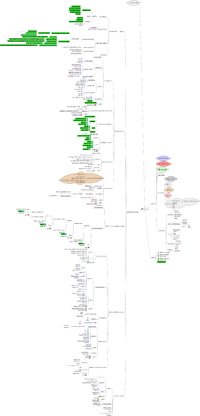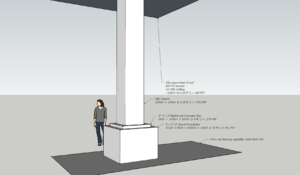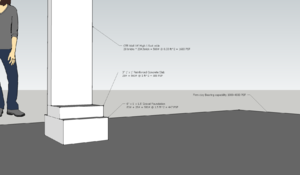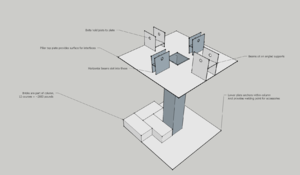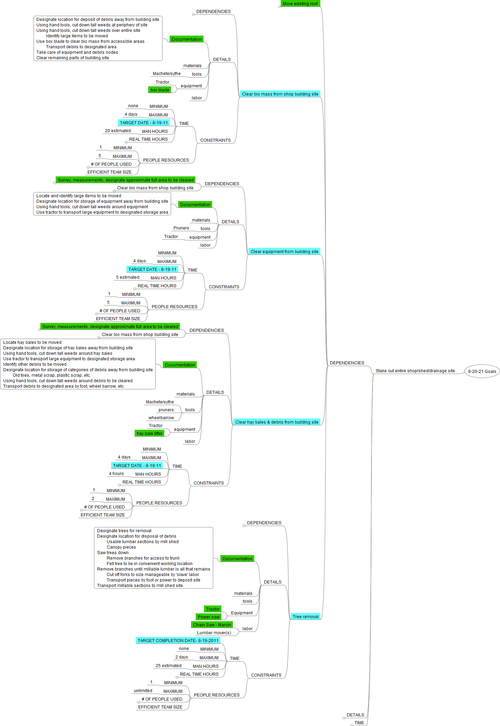OSE Shop 2011: Difference between revisions
No edit summary |
m (→Stringers) |
||
| Line 195: | Line 195: | ||
Wood beam design theory [http://www2.nau.edu/~dsl/egr437/class/woodbeams/design/bending.html# here]. Typical design formulas will tell us to use deep beams for adequate ''stiffness'': otherwise the beam will bend "too much" (1/2" to 1" at midspan according to common design rules). Bending too much might damage the roof covering but is not a dangerous collapse condition. Three other important design criteria are | Wood beam design theory [http://www2.nau.edu/~dsl/egr437/class/woodbeams/design/bending.html# here]. Typical design formulas will tell us to use deep beams for adequate ''stiffness'': otherwise the beam will bend "too much" (1/2" to 1" at midspan according to common design rules). Bending too much might damage the roof covering but is not a dangerous collapse condition. Three other important design criteria are | ||
* ''bearing:'' will the wood crush where it bears on the support | * ''bearing:'' will the wood crush where it bears on the support (this is a concern not only where the beams bear on the columns but also where boxes rest on purlins) | ||
* ''shear:'' will the beam shear apart near its supporting pier | * ''shear:'' will the beam shear apart near its supporting pier | ||
* ''bending strength:'' will the tension in the bottom edge of the beam tear it apart | * ''bending strength:'' will the tension in the bottom edge of the beam tear it apart | ||
Revision as of 05:27, 16 September 2011
Main > Housing and construction
Introduction
This year, we are putting our construction tools (CEB Press, Tractor, Soil Pulverizer, and Power Cube) through the most rigorous field test to date: the construction of 10 living units and a 3,000 square foot fabrication facility here at Factor E Farm. We have already achieved the highest brick pressing rates of any open source model (slide: 16 bricks/minute, 5,000 bricks/day), and now we are aiming to complete the package by achieving $5 per square foot construction costs while remaining within industry standard construction schedules. Our goal is to improve dramatically the efficiency of natural building, far surpassing the benchmarks of earthbag, cordwood, strawbale, cob, rammed earth, adobe, earthship, and papercrete techniques while keeping the ecological footprint to bare minimums. We will publish a full energy accounting report, including embodied energy estimates for materials and the “joules per day” of both biological and electromechanical systems.
So far as we know, this will be a global first: the highest embodied energy efficiencies and the highest construction efficiencies at the lowest cost and with the least environmental impact. Our aim with This Last Mile is to lower the barriers to creating sustainable human settlements by providing access to powerful, low-cost, open source tools that anyone can use to build and transform their environment.
Updates
Technical Implementation
A 12 cell (16'x16') workshop for prototyping and production runs of open source ecology machines
Steps taken to recycle and use a roof structure built as a prototype are shown on the OSE Shop 2011/OSE Mill Shed 2011 page.
See also Hybrid CEB-Straw Superinsulated Housing Plans
See also the prototypical CEB Living Unit
See also Factor_e_Farm_Infrastructure_Buildout_2011
See also
Instructions At This Stage
[Detailed stakeout of building plan]
[Excavate and fill column pad holes]
[Assembly sheet for column pad forms]
[Rebar plan for column footings]
Future Instructions
Forms and Concrete Work
Building CEB Columns
Enclosing the Workshop
CAD Room - Insulation, Raised Floor
Electrical Power in the Workshop
Hydraulic and Pneumatic Plumbing
Water Collection and Distribution
Storm Water Management
Loading Dock
Driveway/Parking Considerations
Design Model
Youtube quick Tour here [http://www.youtube.com/watch?v=gsowoMjSy2I]
Sketchup model: [http://sketchup.google.com/3dwarehouse/details?mid=461634956aef7a94d79276599ab9c72d]
Embed:
Notes for model update
- put tie detail into model for roof beams to roof boxes
- create rebar plan
- reset animation points after model rotation
- generate new animation and walkthrough
- upload to youtube and update wiki
Construction Plan Mindmap
Full size here:[[1]]
Actual Mindmap file here (created with freemind) [[2]]
Supply sources
Sand & Gravel - Larry McFee - Maysville - 816 724-0736
Cost Estimates
Also see Factor_e_Farm_Infrastructure_Buildout_2011
Materials and Budget
- 4 Milwaukee cordless drills - $407
- Roof metal - 136 panels, 17' long (3' widths) - 108 for workshop, 22 for material shed, and 6 extra + flashing for clerestory + screws + flashing closure - total $5871
- 2x6 lumber, $6.60 - total 396 pieces - total $2802
- Glue, #25 star driver bits, 3" star bit screws, 2 glue guns, furring strips, 2 tie downs - $299
- Trailer rental for lumber - $47
Planned:
- Bulldozing and excavation - $2-3k
- Rebar -
- Cement trucks -
Design Notes
Loading Dock
Add a loading dock for easy access to truck bed level deliveries
Driveway
Improve and expand the driveway to be smoother, wider, and double-access (pull-through) and have designated parking spots.
Equipment Room
Build an equipment room in the storage shed.
This will keeps the noise of the compressor, generator, hydraulic pump, and such away from the shop. Will also provide storage for smaller parts. Piping and conduits carry power in various forms into the shop.
Expand Shop
- Moved both last rows of columns out 7.5 feet
- Very moderate cost for 500 additional square feet of space
- Simplifies roof plan.
Storage/Equipment shed on south end
Between the shop and the berm
Use 2x6 for roof boxes
2x6's cost *half* of what 2x10's cost. We're spending almost $3000 on lumber. Can we save $1500?
This calculator externally:
Indicates that 2x6's on 24" centers can be used for our roof box spans easily if our snow load is less than 10 pounds per square foot (about a foot of snow), and probably are even okay for 10 pounds per square foot.
Note, however, that this table lists DeKalb county design snow load at 20psf and this article from a Webster county extension agent recommends 25psf total load. See also ASCE snow load calculations including ridge drift at fig 7-8.
It is my judgement that at least shifting to 2x8's to save cost would be worthwhile. 2 x 6's will work fine, the vast majority of structures use them.
Stringers
(2x6 design for the stringers which support the roof boxes may need to be beefed up. See below.) The first stringer pair has been fabricated and will be load-tested soon.
First Stringer Prototype:
strength analysis
Where columns are on 16x16ft centers, ~256 sq ft of roof is supported on each column, i.e 2560 to 6400 lb (based on assumed total load from 10 psf to 25 psf). This amount of load is transferred from roof boxes to columns through East-West stringers and North-South purlins. If stringers and purlins share the load equally, each 16-foot span must carry 1280 to 3200 lb. Worst case span/load is over CAD room where columns are on 21ft centers rather than 16ft.
Wood beam design theory here. Typical design formulas will tell us to use deep beams for adequate stiffness: otherwise the beam will bend "too much" (1/2" to 1" at midspan according to common design rules). Bending too much might damage the roof covering but is not a dangerous collapse condition. Three other important design criteria are
- bearing: will the wood crush where it bears on the support (this is a concern not only where the beams bear on the columns but also where boxes rest on purlins)
- shear: will the beam shear apart near its supporting pier
- bending strength: will the tension in the bottom edge of the beam tear it apart
Either of the last two failures will cause immediate structural collapse.
Truss option
A simple inverted kingpost truss using steel-bar tension members, added to the 2x6 stringer design, may work well.
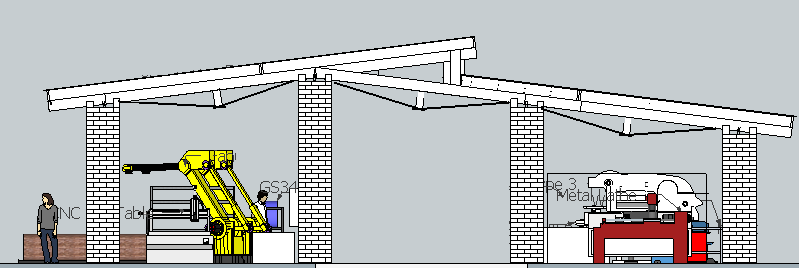
I-joist option
According to this guide I estimate a 12-inch deep PRI-50 IJoist would carry 3200 lb @ 1" deflection (L/180).
Very loose cost estimate: $2.00/linear foot. Approx 375 linear ft in 5 stringer sets = $750.
Technical Notes
Roof Tie
The use of Simpson Strong Tie model 2.5 can bind the roof panels to the rafter boards in such a way as to bind the roof to the rafters. We will use 100 of them, tying all of the edges and middles of the roof boxes to the rafters.
Foundations
The site is a heavy clay soil with a calculated bearing capability of between 1000 and 4000 pounds per square foot. The foundation design goal is to bring the building static load below 1000 PSF, so that the possible live load (gantry crane loaded, snow on the roof) even doubling the load will keep the foundation pressure beneath 2000 PSF.
Work documentation
Preparation
How to make a water level: http://www.youtube.com/watch?v=nAcT_1T25LM
How to lay a brick: http://www.youtube.com/watch?v=lORIZ1shRIM
Instruction pages for each step of the project are being prepared and will be posted periodically as time and availability allow.
Components
- Roof sections
- Roofing materials - Chris
- Stringers for workshop -
Earth Compaction
See Earth Compaction










